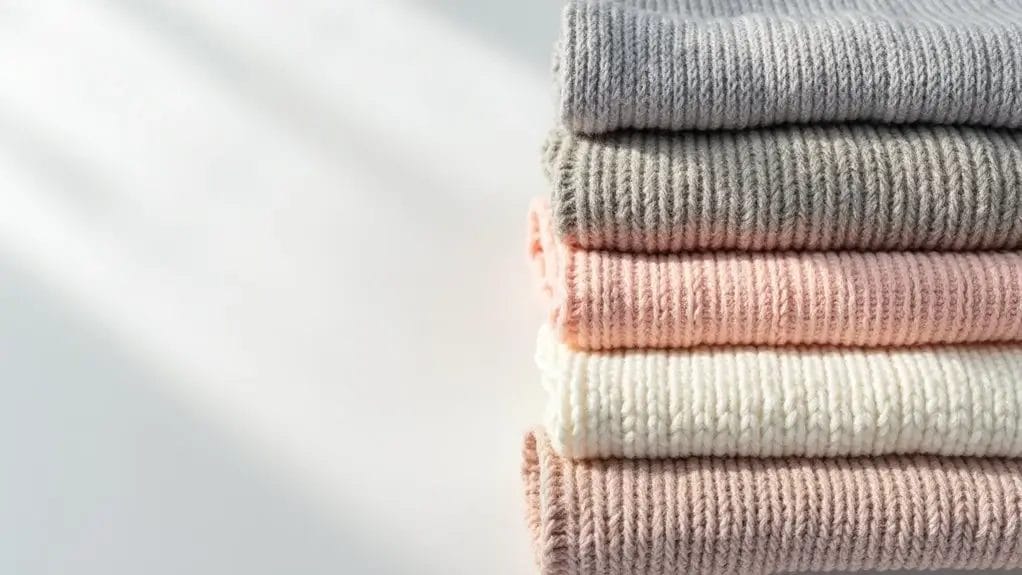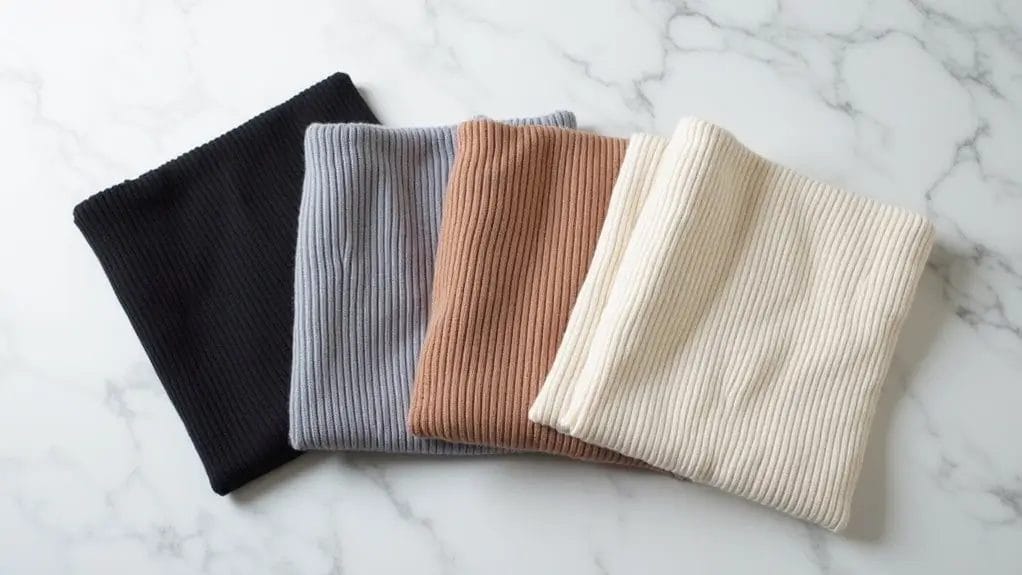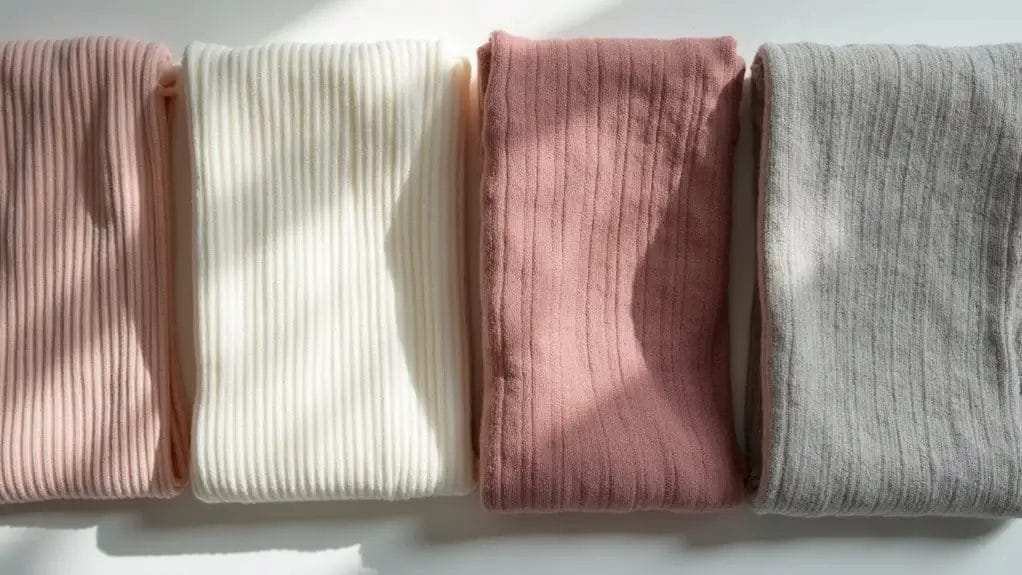You'll find that rib knit fabric's distinctive structure sets it apart in textile manufacturing. When you work with these specialized knits, you're handling materials that combine wales and courses in alternating patterns of raised and lowered stitches. This creates the characteristic ribbed texture you'll recognize in everything from T-shirt collars to sweater cuffs. Understanding the various types of rib knit construction will help you select the right material for your specific garment requirements.
Key Takeaways
- 1x1 rib knit alternates single knit and purl stitches, offering high elasticity and making it ideal for cuffs and neckbands.
- 2x2 rib knit uses pairs of knit and purl stitches to create more texture and stability for waistbands and collars.
- Tubular rib knit features seamless construction, perfect for creating smooth, continuous bands without visible joining seams.
- Interlock rib knit uses double-knit construction for enhanced stability and prevents fabric edges from curling.
- Wide rib knit, including 3x3 and 4x2 variations, creates pronounced vertical ribs suitable for structured outerwear pieces.
Understanding Rib Knit Fabric

Rib knit fabric consists of raised vertical ribs created by alternating knit and purl stitches in a continuous, repeating pattern throughout the material.
You'll find these textiles feature exceptional elasticity and recovery due to their unique construction method, which forms parallel columns of wales on both sides of the fabric.
The material's distinct vertical ridges provide superior stretch in the crosswise direction while maintaining stability in the lengthwise direction, making it ideal for garment cuffs, neckbands, and form-fitting apparel.
What is Rib Knit Fabric?
A distinctive textile construction characterizes rib knit fabric, featuring raised vertical lines created through alternating knit and purl stitches in the manufacturing process.
You'll find this stretchy material offers superior elasticity and texture due to its unique structure.
- Alternating rows of knit and purl stitches create pronounced vertical ribs on both sides.
- The fabric's construction allows for natural stretch, typically 30-50% more than regular knits.
- Vertical lines provide dimensional stability and prevent curling at the edges.
- The ribbed texture creates insulating air pockets, making it ideal for cuffs, collars, and waistbands.
Characteristics of Rib Knits
The essential characteristics of rib knit fabric stem from its specialized manufacturing process, which creates a distinctive balance of structure and flexibility.
You'll notice alternating knit and purl stitches form raised vertical ridges that give rib knits their signature texture and exceptional elasticity.
This construction allows for remarkable stretchiness in the crosswise direction, typically ranging from 25% to 100% depending on the rib pattern.
The fabric's softness varies with different weights, from lightweight 1x1 ribs used in t-shirt collars to heavyweight 2x2 ribs found in sweaters.
The alternating stitch pattern also creates excellent recovery, meaning it'll return to its original shape after stretching.
Different Types of Rib Knit Fabric

You'll encounter several distinct rib knit variations in textile manufacturing, with the most common being 1x1, 2x2, and 3x3 patterns.
The numbers indicate the arrangement of knit and purl stitches on each side, where 1x1 alternates single knit and purl ribs, 2x2 features double ribs, and 3x3 creates wider ribbed sections.
Beyond these standard configurations, you can find specialized variations like 4x2 or 2x1 ribs that offer unique stretch properties and visual textures for specific applications.
1x1 Rib Knit
Single ribbing, known as 1x1 rib knit, creates alternating vertical wales of knit and purl stitches on both sides of the fabric.
You'll find this versatile construction consists of one knit stitch followed by one purl stitch, repeated across each row. This pattern produces a highly elastic fabric with excellent recovery properties.
- Maximum stretch capability reaches up to 100% crosswise and 50% lengthwise.
- Creates a reversible fabric with identical appearance on both sides.
- Produces narrow vertical ribs that stack uniformly.
- Forms a self-curling edge that's ideal for cuffs and hems.
The resulting fabric offers superior flexibility while maintaining its shape through repeated wear and washing.
2x2 Rib Knit
Double ribbing, known as 2x2 rib knit, features alternating pairs of knit and purl stitches that create wider vertical wales compared to 1x1 construction.
This type of rib knit produces a symmetrical pattern where two knit stitches are alternated with two purl stitches on both sides of the fabric.
You'll find this knit pattern offers excellent stretch recovery and stability, making it ideal for cuffs, collars, and waistbands.
The knitted fabric's structure creates pronounced ridges that run vertically, providing more texture and dimensional stability than single rib variations.
When stretched horizontally, 2x2 rib maintains its shape better while offering substantial elasticity.
3x3 Rib Knit
Triple ribbing, known as x3 rib knit, features three knit stitches alternating with three purl stitches to create bold, defined vertical wales. This type of rib knit fabric offers excellent stretch recovery and stability, making it ideal for garment construction where structure meets flexibility.
- Creates wider ribs compared to 1x1 or 2x2 rib knits, providing enhanced visual texture.
- Offers 30-35% crosswise stretch with superior elastic recovery.
- Maintains shape retention through repeated wear and washing cycles.
- Works exceptionally well for cuffs, collars, and waistbands on heavy-weight garments.
You'll find x3 rib particularly suitable for outerwear and winter accessories where substantial fabric structure is essential.
Other Variations
Beyond the common 1x1, 2x2, and 3x3 patterns, rib knit fabric encompasses several specialized variations that serve distinct manufacturing purposes.
You'll find 4x2 rib knit fabric with raised ridges that's ideal for cuffs and waistbands, while 5x3 creates a more dramatic ribbed texture for outerwear.
Different rib combinations like 2x1x1 produce asymmetrical patterns that add visual interest.
Tubular rib knit fabric is made by knitting in a continuous cylinder, eliminating side seams.
Double-sided ribs are created by alternating knit and purl stitches on both faces, resulting in identical appearance and enhanced elasticity.
Specialty Rib Knits and Variations

When selecting specialized rib knit variations, you'll encounter tubular rib knit fabric, which forms a continuous seamless tube ideal for cuffs and neckbands.
Interlock rib knit offers enhanced stability through its double-knit construction, where two 1x1 ribs interlock to create a smooth surface on both sides.
Wide rib knit features pronounced vertical ribs with greater spacing between wales, creating a bold textural effect that's particularly effective in sweaters and winter garments.
Tubular Rib Knit Fabric
Manufacturers produce tubular rib knit fabric in a seamless cylindrical form using specialized circular knitting machines. This continuous tube structure eliminates side seams and creates uniform stretch properties throughout the material.
- You'll find tubular rib knit commonly used in sweater cuffs and waistbands due to its superior elasticity and recovery.
- The fabric's double-sided construction provides identical appearance on both sides, making it reversible.
- Its seamless structure reduces waste during garment production and enhances comfort.
- You can cut the tube lengthwise to create flat panels while maintaining the rib knit's natural stretch properties.
The material's inherent stability and shape retention make it ideal for performance wear and commercial applications.
Interlock Rib Knit
Though similar in appearance to standard rib knits, interlock rib knit fabric features a unique double-knit construction where two layers of 1x1 ribbing interlock to create a more stable, reversible material.
You'll find this fabric's structure combines two knit stitches on both sides, eliminating the traditional ribbed appearance on the reverse.
Among different types of rib knit fabric, interlock offers superior stability while maintaining moderate stretch.
It's heavier than single-layer stretchy fabrics yet drapes well.
The interlocking construction prevents curling at the edges - a common issue with standard fabric and ribbing. This makes it ideal for garment applications requiring a clean finish without additional stabilization.
Wide Rib Knit
Unlike standard rib knits, wide rib knit fabric features prominently raised ribs that typically measure between 3-6 wales per inch, creating bold textural patterns and dramatic surface interest.
- This type of fabric alternates wider rows of knit and purl stitches than single rib, delivering enhanced dimensional effects.
- Wide ribs provide superior stretch recovery and stability compared to narrow ribs.
- You'll find this knit fabric is a type that's exceptionally comfortable to wear in garments.
- It's commonly manufactured using different fibers like cotton, wool, and synthetics.
- The structure maintains its shape better than standard ribs while offering thermal insulation.
Common Applications of Rib Knit Fabrics

You'll commonly find rib knit fabrics in garment components that require excellent stretch recovery and a snug fit, particularly in cuffs, neckbands, and waistbands.
The fabric's alternating ribs create natural elasticity that makes it ideal for form-fitting garments like sweaters, turtlenecks, and fitted t-shirts.
Rib knits also excel in athletic wear and undergarments where the fabric needs to maintain its shape while accommodating body movement.
Cuffs and Waistbands
Rib knit fabric's elasticity and recovery properties make it the ideal choice for cuffs and waistbands in garment manufacturing.
When you're sewing with rib knits, you'll find they naturally spring back into shape after stretching, which helps keep the garment in place during wear.
- Neckbands made from rib knit provide a snug fit around the collar while maintaining comfort and flexibility.
- Waistbands stretch to accommodate movement but retain their original form.
- Sleeve cuffs on sweatshirts and jackets prevent cold air from entering.
- Band widths typically range from 1-3 inches depending on the garment's design requirements.
Garments Made from Rib Knits
Many popular garments utilize rib knit fabric as either the primary material or as an essential component in their construction.
You'll find rib knits in high-end sweaters, where the fabric's natural stretch and recovery provide excellent drape and comfort. T-shirts often feature rib knit collars and sleeve endings, while activewear incorporates this material for its compression properties.
Leggings made from rib knit offer superior fit and flexibility. Performance jackets commonly include rib knit waistbands and cuffs for enhanced mobility.
The fabric's versatility makes it ideal for both standalone garments and as trim elements in various clothing applications.
Choosing the Right Type of Rib Knit

When selecting your ideal rib knit fabric, you'll need to evaluate the stretch percentage and recovery rate to guarantee proper fit and garment longevity.
You should examine the fabric's weight and thickness specifications, typically measured in GSM (grams per square meter), to match your project's structural requirements.
Match your rib knit selection to your specific application by considering factors such as end-use stress points, washing requirements, and seasonal wear conditions.
Considering Stretch and Recovery
Understanding stretch and recovery characteristics will determine your rib knit fabric's performance in the final garment.
These stretchy and comfortable materials are essential for close-fitting garments and need proper evaluation before use.
- Test the fabric's stretch percentage by pulling it in both directions - a quality rib knit should stretch 50-75% crosswise and 25-35% lengthwise.
- Check recovery by stretching and releasing - fabric should return to its original shape within seconds.
- Consider spandex content (typically 2-5%) for enhanced elasticity that makes it ideal for waistbands.
- Evaluate the fabric's stability under tension to prevent permanent deformation during wear.
Assessing Weight and Thickness
Beyond stretch properties, the weight and thickness of rib knit fabric directly impact its end-use performance.
You'll find lightweight rib knits ideal for form-fitting garments and layering pieces, while medium-weight rib creates more structure and warmth. The fiber content considerably influences the knit fabric's weight - cotton fabric tends to be heavier than synthetic alternatives.
When selecting your rib knit fabric's weight, consider the garment's intended use.
Lighter weights (150-200 GSM) work well for t-shirts and underwear, while medium weights (200-300 GSM) suit sweaters and jackets.
Test the fabric's drape and body by holding it up - heavier ribs will show more pronounced texture.
Matching Rib Knits to Your Project
Selecting the right rib knit structure directly impacts your project's success.
When working with rib knits, match the fabric's properties to your garment's requirements for ideal results. Consider these essential factors while choosing your material:
- 1x1 ribs are perfect for garments requiring maximum stretch and recovery, ideal for projects like cuffs and neckbands.
- 2x2 ribs create stylish textures and provide balanced stability, excellent for sweaters and dresses.
- 3x3 ribs alternate wider wales, offering structured drape for statement pieces.
- 4x4 ribs deliver bold texture and moderate stretch, making them suitable for jackets and outerwear.
Tips for Sewing with Rib Knit Fabric

To successfully work with rib knit fabric, you'll need a ballpoint or stretch needle, polyester thread, and a walking foot attachment for your sewing machine.
You'll achieve the best results using a narrow zigzag stitch with reduced presser foot pressure and slightly lengthened stitch settings.
When attaching ribbing to garment edges, you'll want to use a 1:0.8 ratio between the main fabric and the rib knit to guarantee proper tension and recovery.
Recommended Sewing Techniques
When sewing with rib knit fabric, you'll need specific techniques to guarantee professional results and maintain the material's signature stretch properties.
Since rib knit fabric is known for its elasticity, you'll want to focus on methods that preserve its natural characteristics.
- Use a ballpoint or stretch needle (size 70/10 or 80/12) to prevent skipped stitches and fabric damage.
- Set your machine to a narrow zigzag stitch (width 0.5-1.5mm) that gives the fabric room to stretch.
- Apply light pressure when feeding the fabric through your machine.
- Test your tension settings on a scrap piece before starting your project.
Tools and Notions for Working with Rib Knits
Since successful rib knit construction depends heavily on proper tool selection, you'll need specialized equipment designed for stretchy materials.
Your basic toolkit should include stretch needles (sizes 70/10 - 90/14), walking foot attachment, double needle, and quality polyester thread compatible with synthetic fibers.
For lightweight rib knit fabric often used for sweaters, choose ball-point needles that slip between fibers rather than piercing them.
When working with nylon-blend knit fabric's edges, a rotary cutter, pattern weights, and wash-away stabilizer tape become essential tools.
Select a serger with differential feed for professional seam finishing.
Frequently Asked Questions
How Do I Prevent Rib Knit Fabric From Curling at the Edges?
Stabilize your rib knit's edges by applying fusible interfacing tape, steaming while stretching the fabric flat, or adding a straight stitch 1/4 inch from the raw edge before construction.
Can I Use Regular Sewing Machine Needles for Rib Knit Fabrics?
You'll need stretch or ballpoint needles for rib knits. Regular needles can damage the fabric's elastic fibers, causing skipped stitches and runs. Use 70/10 or 80/12 size stretch needles.
What Is the Average Lifespan of Rib Knit Garments?
You'll get 1-3 years from your rib knit garments with regular wear, though lifespan varies based on fabric weight, fiber content, washing frequency, and your garment care practices.
Does Rib Knit Fabric Shrink More Than Other Knit Fabrics?
You'll find that rib knit typically shrinks 3-5% more than single jersey knits due to its compressed structure and higher elastic recovery properties during washing and drying cycles.
Are There Special Washing Instructions for Colored Rib Knit Fabrics?
You'll need to wash colored rib knits in cold water, using color-safe detergent. Turn garments inside-out, avoid harsh agitation, and dry on low heat to prevent dye bleeding and maintain elasticity.
Conclusion
You'll find that selecting the right rib knit fabric directly impacts your garment's success. Whether you're working with 1x1 for elasticity, 2x2 for stability, or specialty variations like tubular rib, each type serves specific manufacturing requirements. Consider your end-use requirements, evaluate the fabric's technical specifications, and match them to your production needs. Remember to adjust your machinery settings and needle selection accordingly.


0 comments